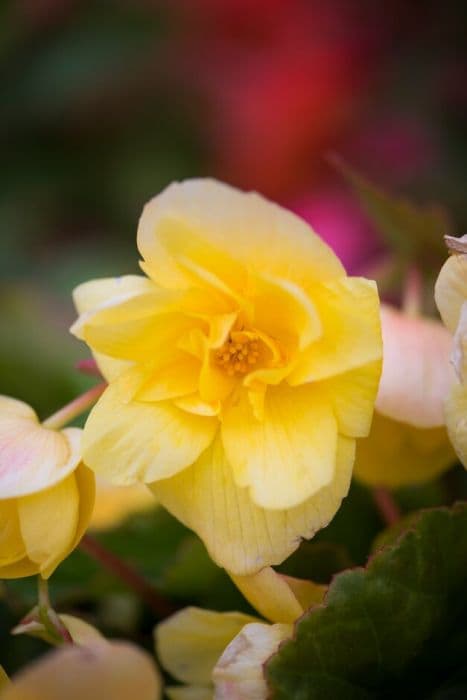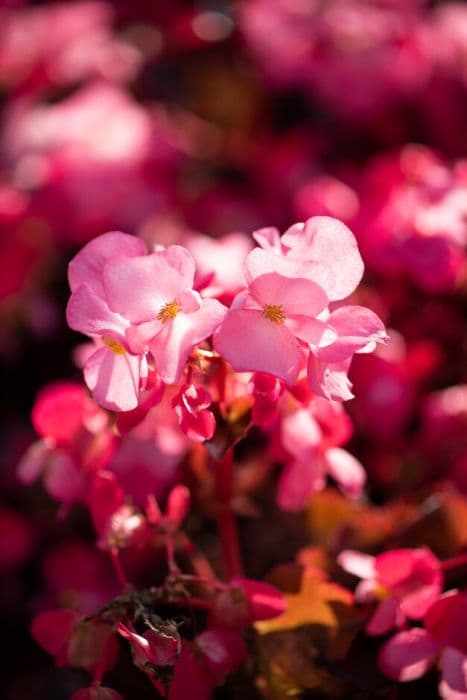Benitochiba Begonia Begonia 'Benitochiba' (R)

ABOUT
Begonia 'Benitochiba' is a strikingly ornamental plant known for its vibrant foliage that draws instant attention. The leaves of this begonia variety are large and somewhat heart-shaped, displaying a rich tapestry of colors. The surface texture often appears crinkled or puckered, giving each leaf a unique, tactile quality. The top side of the leaves showcases a mix of green and reddish-pink hues, often blending in a gradient that radiates from the center toward the edges. Depending on the light and growing conditions, you might find the green ranging from deep hues to more subtle olive tones, with the red-pink shades varying from bright to more subdued burgundy. A distinctively attractive feature of the Begonia 'Benitochiba' is the contrasting color of its leaf undersides, which are typically a bold, deep red. This dramatic color contrast is particularly eye-catching as the leaves move in the breeze, intermittently revealing their vibrant undersurface. Contrasting with the colorful foliage are the stems, which can be robust and also carry the red coloration, adding another layer of visual interest to the plant's overall appearance. While flowers are not the primary draw for this begonia variety, it may produce small blooms. These flowers are often seen as a secondary feature due to the dominance and ornamental appeal of the foliage, which remains the star attraction throughout the growing season. In terms of texture, Begonia 'Benitochiba' has a lush, full appearance, and despite eliminating any mention of specific dimensions, the plant presents itself with a substantial presence, capable of serving as a centerpiece in a garden display or as a focal point among houseplants in an indoor setting. Its aesthetic allows it to blend well with other plants while still holding its own as a distinct and visually captivating botanical specimen.
About this plant
 Names
NamesFamily
Begoniaceae
Synonyms
Benitochiba Begonia, Metallic Leaf Begonia, Shrub Begonia
Common names
Begonia 'Benitochiba'
 Toxicity
ToxicityTo humans
Begonias, including the 'Benitochiba' Begonia, contain insoluble oxalates which can be mildly toxic when ingested. If parts of the plant are eaten, common symptoms can include a burning sensation in the mouth, lips, tongue, and throat, as well as difficulty swallowing and nausea. In severe cases, it can cause vomiting and diarrhea. Contact with the sap of the plant may cause skin irritation in sensitive individuals.
To pets
Begonias, such as the 'Benitochiba' Begonia, are toxic to pets due to the presence of insoluble oxalate crystals. If a pet consumes parts of this plant, it may exhibit symptoms such as oral irritation, excessive drooling, vomiting, and difficulty swallowing. In severe cases, ingestion can lead to gastrointestinal upset and respiratory difficulties. It is important to prevent pets from chewing on or ingesting this plant.
 Characteristics
CharacteristicsLife cycle
Perennials
Foliage type
Evergreen
Color of leaves
Mixed
Height
1-2 feet (30-60 cm)
Spread
1-2 feet (30-60 cm)
Plant type
Herb
Hardiness zones
10
Native area
Asia
Benefits
 General Benefits
General Benefits- Ornamental Value: Begonia 'Benitochiba' is prized for its striking foliage with a unique reddish hue, adding aesthetic appeal to gardens and indoor spaces.
- Easy to Grow: It is a relatively low-maintenance plant, making it suitable for both experienced and novice gardeners.
- Shade Tolerance: This variety of begonia thrives in shaded areas, offering a vibrant addition to parts of the garden that receive little sun.
- Drought Resistance: Once established, it can tolerate periods of dryness, making it a practical choice for water-wise gardening.
- Container Gardening: Suitable for pots and containers, it allows for flexibility in garden design and can be used to enhance balconies and patios.
- Versatility: The plant can be used in various gardening styles, including borders, bedding, and as a focal point.
- Seasonal Interest: With a long flowering season, it provides color and interest throughout much of the year.
 Medical Properties
Medical PropertiesThis plant is not used for medical purposes.
 Air-purifying Qualities
Air-purifying QualitiesThis plant is not specifically known for air purifying qualities.
 Other Uses
Other Uses- Begonia 'Benitochiba' can be used in terrariums due to its high humidity requirements, providing a vibrant pop of color among other foliage plants.
- The leaves of Begonia 'Benitochiba' can be pressed or dried and used in craft projects such as creating botanical art pieces or natural decorative motifs.
- This plant can be part of educational projects or botany studies to demonstrate hybrid plant varieties and horticultural breeding techniques.
- Begonia 'Benitochiba' provides an excellent opportunity for photographers and artists to capture its unique foliage and texture, making it a subject for botanical illustration.
- Use the plant as a living gift to symbolize friendship or care, as begonias are often associated with these sentiments.
- Incorporate Begonia 'Benitochiba' into a fairy garden, taking advantage of its vibrant foliage to enhance the mystical appeal of the miniature landscape.
- Leaves of the Begonia 'Benitochiba' can be used in a natural dye-making process for fabrics, yielding unique colors and patterns.
- Small clippings of Begonia 'Benitochiba' can be used as natural confetti for eco-friendly events or biodegradable decorations.
- When creating a sensory garden, include Begonia 'Benitochiba' to provide a tactile experience with its textured leaves.
- Begonia 'Benitochiba' can serve as an indicator plant in a garden or greenhouse, with its well-being suggesting the environmental conditions, helping in the management of other plants.
Interesting Facts
 Feng Shui
Feng ShuiThe Rex Begonia is not used in Feng Shui practice.
 Zodiac Sign Compitability
Zodiac Sign CompitabilityThe Rex Begonia is not used in astrology practice.
 Plant Symbolism
Plant Symbolism- Caution - Begonia often symbolizes cautiousness or a feeling of warning, reminding us to be wary or tread carefully in certain situations.
- Uniqueness - The distinctive and varied foliage of 'Benitochiba' Begonia represents uniqueness and the celebration of individuality.
- Harmony - In some cultures, Begonias suggest peacefulness and harmony, inviting balance into one's life.
- Gratitude - Giving a Begonia plant like 'Benitochiba' can be an expression of thanks or appreciation.
 Water
WaterRex Begonias like 'Benitochiba' should be watered when the top inch of the soil feels dry. This is typically once every 7 to 10 days, but the frequency could increase if the air in your home is very dry. When it's time to water, do so thoroughly, allowing excess water to drain away, ensuring that the plant receives about 8-16 ounces of water. Make sure not to let the plant sit in water as this can lead to root rot. During the winter months, reduce watering to prevent overwatering as the plant's growth slows down.
 Light
LightRex Begonias, including 'Benitochiba', thrive in bright, indirect light. A north-facing window or a spot that is a few feet away from an east or west-facing window would be ideal. Direct sunlight should be avoided as it can scorch the leaves of the plant. However, too little light can lead to leggy growth and poor leaf coloration.
 Temperature
TemperatureBegonia 'Benitochiba' prefers temperatures between 60 and 75 degrees Fahrenheit and should not be exposed to temperatures below 50 degrees Fahrenheit as it can cause damage to the plant. The ideal temperature conditions for this Begonia are to keep it in an environment that consistently stays within the above range. Avoid placing it near drafts or heating and cooling vents where the temperature can fluctuate.
 Pruning
PruningPrune your Rex Begonia 'Benitochiba' to maintain its shape and encourage bushier growth. This should be done as needed, typically when you notice dead or dying leaves or if the plant is becoming too large for its space. The best time to prune is in the spring, but you can remove dead leaves at any time of the year to keep the plant healthy.
 Cleaning
CleaningAs needed
 Soil
SoilThe Begonia 'Benitochiba' prefers well-draining, fertile soil with plenty of organic matter; a mix of peat moss, perlite, and compost is ideal. Aim for a soil pH between 5.5 and 6.5.
 Repotting
RepottingRex Begonias like Begonia 'Benitochiba' should generally be repotted every 2 to 3 years or when they outgrow their current pot.
 Humidity & Misting
Humidity & MistingBegonia 'Benitochiba' thrives in high humidity, ideally between 50% and 70%. Using a pebble tray or humidifier can help maintain these levels indoors.
 Suitable locations
Suitable locationsIndoor
Place in bright, indirect light; maintain high humidity.
Outdoor
Shelter from strong sun; protect from frost; enjoy in summer.
Hardiness zone
10-11 USDA
 Life cycle
Life cycleBegonia 'Benitochiba' begins its life as a seed, which germinates in warm, moist soil under partial shade. Upon sprouting, it develops into a seedling with characteristic asymmetrical begonia leaves, and over several weeks, it forms a small rosette as it enters the vegetative growth stage. As the plant matures, it grows larger and bushier, with its leaves developing a metallic reddish-bronze hue and a crinkled texture indicative of this cultivar. Flowering typically occurs in warm seasons, producing small clusters of white or pink flowers, though the plant is primarily grown for its attractive foliage. After its blooming period, if conditions are unfavorable or at the end of its growing season, the above-ground parts may die back, while the tuberous root system can remain dormant until favorable conditions return. Begonia 'Benitochiba' can be propagated through leaf cuttings or division, starting the cycle anew with the establishment of genetically identical offspring.
 Propogation
PropogationPropogation time
Spring-Early Summer
Begonia 'Benitochiba', commonly referred to as Rex begonia, is commonly propagated through leaf cuttings. This propagation method is best performed during the plant's active growing season, typically spring or early summer. To propagate by leaf cuttings, select a healthy, mature leaf and cut it into wedges, ensuring that each piece has at least one of the main veins. These wedges are then placed on a moist potting mix, vein side down. Ensure the cuttings are gently pressed into the soil and covered lightly with a thin layer of soil or vermiculite. The pot should be placed in a warm environment with bright, indirect light and kept moist. Roots will typically develop within a few weeks, after which the new plants can be transferred to individual pots.


![Begonia [Bonfire]](/_next/image?url=https%3A%2F%2Fplants-admin.emdemapps.com%2Fimages%2Fplants%2F%2Fimages%2F604b6124363f0.png&w=640&q=75)


![Begonia [Devotion]](/_next/image?url=https%3A%2F%2Fplants-admin.emdemapps.com%2Fimages%2Fplants%2F%2Fimages%2F604b58183573b.png&w=640&q=75)



